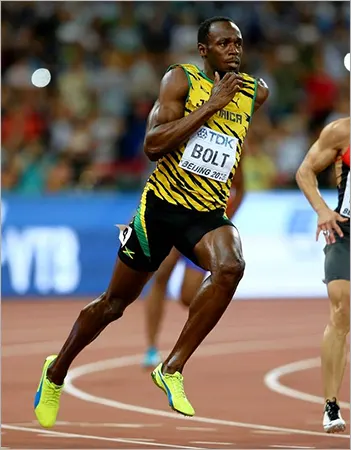- 1-Mile World Record
- What Can We Learn from Fast Mile Runners?
- How Long Does it Take to Run a Mile on Average?
- Physiological Characteristics Pertaining to the Fastest 1-Mile
- Speed – A Vital Imperative
- Leg Strength – A Pivotal Imperative
- Precautions to Take while Preparing for Your Fastest Mile Run Ever
- Preparation to Run a Mile in 4 Minutes
- FAQs
Track and field is a testament to what is possible with hard work, dedication, and a love of the sport (plus a good genetic component). And there is no doubt that one can learn a lot from the fastest mile ever run in history.
People tend to think that there is no benefit to running hard in short-distance races, but that isn’t quite the truth. To improve your pace at any distance, it is crucial to work on your mile times.
Whether you want to run the first mile without walking, improve your overall speed, or motivate your training, it should serve a variety of purposes!
These elite runners have the potential to teach you the value of consistency, mental strength, and smart training, as well as hope! The mile times that follow show that there is a huge gap between improvement and betterment, but the runners continue to pursue their goals.

The fastest mile time is the fastest time a runner can run a distance of one mile (approximately 1600 meters). The mile run, a middle-distance foot race, is an athletics event governed by the World Association of Athletics Federations.
As per Britannica, World Athletics is an international athletics organization of national associations with more than 160 member countries. It is also known as the International Association of Athletics Federations (IAAF).
1-Mile World Record
The world record for the fastest mile ever run is currently held by Hicham El Guerrouj of Morocco in 1999 at 3 minutes and 43.13 seconds. He made this record at the Rome Diamond League meet at the Olympic Stadium in Rome. Having won two Olympic gold medals in the 1500 meters and numerous world championships, he is considered one of the greatest middle-distance runners of all time.
The women’s world record is held by Sifan Hassan from the Netherlands at 4:12.33. She is a middle-distance runner as well and is the champion of 1500 m in 2016. She is also the world record holder in the 5k run. Hassan entered herself in the mile run at the 2019 Herculis event in Monaco and made history by breaking the previous record of 4:12.56. And interestingly, the previous record, which was held by Svetlana Mastarkova, had remained untouched for 23 years!
What is Usain Bolt’s Mile Time?
This is a man who knows his strength, and that is the 100 m sprint. He has never been seen running an organized 1-mile race. But if he could maintain that powerful speed, he would have definitely broken the record.
His 100 m time is 9.58 seconds, or 27.73 mph, which translates to 2 minutes and 9.8 seconds in the mile.

Countless other runners have explored the possibilities of running the mile, and each new performance has contributed to the rich history of this classic distance race.
One needs to either have a natural talent or has to go through rigorous training and have a strong mindset. The runners must focus on developing their speed, endurance, and technique to perform at the highest level. Their training programs should include different types of workouts like tempo runs, intervals, hill repeats, etc., for building up both endurance and speed.
Additionally, the runners are also expected to focus on maintaining a proper form and technique, like a fast rhythm, and avoid overstriding. Apart from this, mental preparation is also important. The runners have to have a competitive attitude in order to stay focused on their goals.
With dedication and hard work, it is possible to achieve your own personal best and maybe even challenge the world record for the mile!
What Can We Learn from Fast Mile Runners?
So now the question is, what can we learn from the history of the mile and the runners who have pushed its limits? Firstly, we know that the mile is a true test of speed, endurance, and determination.

The history of the fastest mile run in history is a testament to the power of human performance and the impact one runner can have on the sport. From Roger Bannister to Hisham El Guerrouj to Sifan Hassan, record-breaking runners have inspired the next generation of runners to aim higher and push the limits of what is possible.
Whether you are a seasoned runner or just starting out, the Mile has a special appeal that continues to inspire people to go faster and push their limits.
Mile Times Make a Big Difference
The next time someone asks you if five minutes a mile is fast, just say, “Sure.” And if someone asks you, “Is 6 minutes fast?” you can answer, “Definitely.” Honestly, they just put numbers on the scale, so the real answer is that they are all great.
But to be at the elite level, you need to be under 4 minutes for women and 4 minutes for men. And it certainly takes a special person to run the fastest mile run times in history!
The average runner cannot come close to these times. For a beginner, around 12 minutes per mile would be reasonable.
Running a Mile Entails Speed & Endurance
The mile is considered one of the most endurance-intensive events in track and field. This means that one must practice both running at top speed and maintaining speed over distance.
By running longer distances than shorter distance track and field athletes, they develop endurance. They then spend time working on both form and speed.
You may have noticed that your muscles are less large than a sprinter’s. This is because it is an endurance sport.
How Long Does it Take to Run a Mile on Average?
It is pretty evident that age affects how fast you run. Most runners reach their fastest speeds around the ages between 18 and 30. Moreover, it varies from person to person what their average running speed is per mile for a 5-kilometer race.
Differences between men and women affect running pace. One reason male elite athletes often run faster times than female elite athletes has to do with muscle mass. Having more fast-twitch muscles in the legs can lead to faster speeds.
However, as per a study, women may have an advantage over longer distances. In marathons, during the race, non-elite men are more likely to slow down than women. The researchers believe that this can be due to decision-making and physiological differences between the two.
An effective way to start your personal fastest mile ever journey is by running a 5K race to improve your health instantaneously.
How Important is Pacing for Distance Running
In distance running, pace or speed is an important aspect. It is the number of minutes that it takes someone to run a mile or a kilometer, and it also impacts how fast one can complete a run. For instance, one may want to slow down their pace in the first few miles of the run.
By doing this, one may have more energy stored up to power through the last few miles with everything they have got. If someone is an elite runner, they will run at a moderate speed at the start of the race and increase it at the end.
To get an idea of your average pace, try the following fitness test: run one mile on a flat area near your home or one mile at a nearby track.
Warm up for 5–10 minutes; you can do hyperbolic stretches for the same. As you run the one mile, time yourself. Be aware that you are not running at full speed but rather at a pace that pushes you.
This one-mile time can be used as a speed goal for your training. As you gain speed and endurance, return to the 1-mile loop every few weeks and repeat measuring your 1-mile time.
Physiological Characteristics Pertaining to the Fastest 1-Mile
There are some physiological factors that many might not know about that lead to the fastest 1 mile. As half of the mile events are aerobic and anaerobic, the body transitions from an aerobic to an anaerobic state and then starts to fatigue with the production of lactic acid.
Hence, it is crucial to develop both physiological aspects for the optimization of your performance. Blending into a well-balanced combination of speed work, endurance training, and recovery exercises contributes to improvements in both aerobic and anaerobic capacities. Ultimately paving the way to achieve the fastest mile ever run.
Training consistently and also allowing your body to recover at the same time will not only make you faster but also lessen the possible risks of injury and burnout. If you develop your physical capabilities and stay committed to your training plan, you will notice gradual improvements in your mile time. And you will eventually be able to reach your fastest mile ever.
Taking the aerobic element first, leading physiologists are all in agreement that the oxygen uptake (VO2 max) is best improved by work in the range of 80-100% VO2 max.
A strong aerobic capacity plays a crucial role in improving overall endurance and performance. This is often achieved through activities such as long-duration, low-intensity runs, interval training, and tempo runs aimed at increasing your cardiovascular strength and efficiency.
The other half of the equation – the anaerobic component – can be developed through strength training, hill sprints, and speed work sessions, which help to increase power, resilience, and sprinting capabilities.
By incorporating both aerobic and anaerobic training elements into your regimen, your body becomes better equipped to manage the changes in energy requirements, thus optimizing your ability to achieve your fastest mile ever.
Therefore, in addition to slow aerobic runs, such as long runs at marathon speed and basic runs, you must incorporate about 20% of your schedule for running in the 80-100% zone.
In terms of improving lactate tolerance, one effective way to improve lactate tolerance is tempo running.
The proper pace for tempo running is the point at which the body transitions from aerobic to anaerobic work, sometimes referred to as the anaerobic threshold.
People who aim for a sub-4 minute per kilometer pace often run tempo runs at a pace of around 3:07 per kilometer or 5 minutes per kilometer.
Interval training at a pace that is considered anaerobic also increases the ability to run faster than the target speed to maintain a distance of one mile. It also increases the likelihood that the body will be prepared to achieve the goal.
According to Frank Horwill, the anaerobic requirements for the pace listed are,
- 100 m – 100%
- 200 m – 95%
- 400 m – 83%
- 800 m – 67%
- 1 mile – 50%.
Now let’s have a look at speed, as it plays an essential role in every part of the fastest mile ever run.
Speed – A Vital Imperative
The best 800 m time seems to have a direct impact on the potential of the mile. Generally speaking, an athlete should be able to run the 800 m in 1:51.50.
For example, former mile world record holder John Landy had the best 800 m time of 1:51.30 and a mile time of 3:58.
Because 800 m potential is limited by 400 m speed, athletes need to be exposed to sprinting as early as possible in their track and field journey.
Some world-class milers have been competing in 200 m and 400 m races since their teenage years to gain the necessary speed.
Steve Ovett, for example, was the British interschool 400 m champion at age 15 and has since had an illustrious career, breaking the world record for the mile twice.
Frank Horwill was fond of saying, “Don’t lose sight of speed.” Thus, within the framework of the long-term athlete, the emphasis on speed development is paramount.
An athlete should be able to perform 3×4×200m sessions at an 800 m pace, 30 seconds between reps, 6 minutes between sets, and 27.5 seconds/28 seconds. Certainly, this is not for the faint of heart.
Also, if you compete in the 400 m run, you will most likely be able to run under 50 seconds.
So, participating in as many 4×400 relay events as possible from a young age is a plus for athletes aiming to break 4 minutes in the mile.
Leg Strength – A Pivotal Imperative
An athlete’s leg strength directly affects how fast he or she runs. Hills are a great way to build leg strength. Several sessions can be performed. A classic session that can be used in any season is 6–10 repetitions of a 100-meter hill at a moderate grade, followed by a jog back to recover.
Strength training is another effective way to increase leg strength. Lengthening the stride increases the speed of the sprint.

Exercises such as squats, lunges, burpees, squat thrusts, one-legged squats, and calf raises are effective. Perform two circuits of 10–15 repetitions of each exercise.
Sebastian Coe and his coach understood the importance of leg strength. Therefore, he dedicated three sessions a week in the winter to weight training and hill running, supplemented by sessions at an estimated 5 km pace.
Precautions to Take while Preparing for Your Fastest Mile Run Ever
If you are new to running, it is important to increase your mileage gradually to avoid injury. As you gain speed and endurance, increase your mileage by a few miles every two weeks.
Also, to ensure a safe and healthy running experience, please observe the following precautions.
- Do not wear headphones when running on the road. Do not wear headphones when running on the road.
- Run against traffic.
- Obey traffic rules. Check both sides of the road when crossing the street.
- Run in well-lit, safe areas. Wear reflective gear early in the morning and at night.
- When running, bring water with you or run on a route where water is available, and stay hydrated while training.
- Carry identification with you when you run. Tell a friend, roommate, or family member where you are going.
- If possible, run with a family member or dog.
- Wear sunscreen when running outdoors.
- Wear loose, comfortable clothing and appropriate running shoes.
- Change running shoes every 300–500 miles.
- Warm up before running and stretch afterward.
- Cross-train once or twice a week to vary your routine and strengthen your muscles.
With these vital precautionary steps, you can ensure that your first mile will be your fastest and the safest as well. Please adhere to these steps in order to avoid injuries and to allow yourself to reach your full potential while running your fastest mile ever.
Preparation to Run a Mile in 4 Minutes
The age at which an athlete is most likely to break 4 minutes for the mile for the first time is now 22.
In the 1960s, the youngest person ever to break 4 minutes for the mile was 17-year-old Jim Ryun, who has since broken world records in the mile, 1,500 m, half-mile, and 800 m.
In recent decades, however, Alan Webb (3:53 as a high school athlete) and, in May 2022, Gary Martin (high school athlete) ran a sub-4 minute mile in 3:57.98 without pacer assistance.
Norwegian athlete and current 1500 m Olympic champion Jakob Ingebritsen is the youngest runner to officially run a sub-4 minute mile, clocking 3:58.07 in May 2017 at age 16 and 250 days.
There have been various approaches to mileage training over the years. The famous New Zealand coach Arthur Liddiard, a firm believer in the need to build a solid aerobic foundation, had his athletes achieve 100 miles per week with steady-state running for ten weeks. Followed by several weeks of fartlek-type hill running over huge sand dunes. He had his athletes run on giant sand dunes for numerous weeks.
One of his protégés, Peter Snell, was then unbeatable in the 1500 m and mile distances for the rest of his life.
Sebastian Coe and his coach, on the other hand, understood and stressed the importance of leg strength, so he devoted himself to weight training and hill running three times a week in the winter.
If you don’t have the components to break the four-minute mile barrier, why not try the unorthodox method practiced by Northern Ireland’s Allan Bogle?
To achieve his goal of breaking the 4-minute mile, Allan Bogle surveyed the terrain throughout Northern Ireland to find the steep downhills where he was most likely to break the 4-minute mark. See how he did it here! You can use this approach as well to ease into yourself the 4-minute mile run.
Along with applying strategy to practicing for the mile, you must also consider the importance of building up your resilience to run for longer distances. For instance, prepare to run the mile in 10 minutes first, then plan accordingly to run it in 6 minutes, and simultaneously decrease the time until you can run it within 4 minutes.
FAQs
Ans: The fastest time for the mile by a male athlete is 3:43.13, as per the Guinness World Records.
Ans: Usain Bolt’s 1-mile time is 3 minutes, 41.13 seconds.
Ans: The relatively fit and non-competitive runners usually run an average of about 9–10 minutes per mile. A beginner may be able to run a mile in 12–15 minutes, approximately, if their endurance gets improved. Elite marathon runners average about 4–5 minutes per mile.
Ans: Running a mile in six minutes is recognized as the true test of a recreational runner. It is fast, but not elite speed. And with will and dedication, many can achieve it.
Ans: Bagging a 7-minute mile is an awesome goal for any recreational runner. While it’s a fast pace, with determination and hard work, it’s definitely achievable. Plus, running a mile is quite a good distance to race!
Ans: Now, it’s the standard for professional middle-distance runners.
Ans: A beginner runner might be able to run a mile in 12 to 15 minutes. On the other hand, a comparatively fit and non-competitive runner may usually run an average of 9 to 10 minutes in a mile. In the case of elite marathon runners, they might run an average of 2 to 5 minutes per mile.
Ans: In the United States, high school boys from most states can run a sub-4:00 mile and are highly competitive in high school track. The high school girls, on the other hand, can run a sub-5:00 mile.
Ans: It has been broken by 1,664 athletes.
Ans: According to Guinness World Records, the fastest mile time by a male athlete is 3:43.13, achieved by two-time Olympic medalist Hisham El Guerrouj. He represented Morocco in Rome on July 7, 1999. The fastest mile run by a female athlete is 4:12.33.
ALSO READ:










